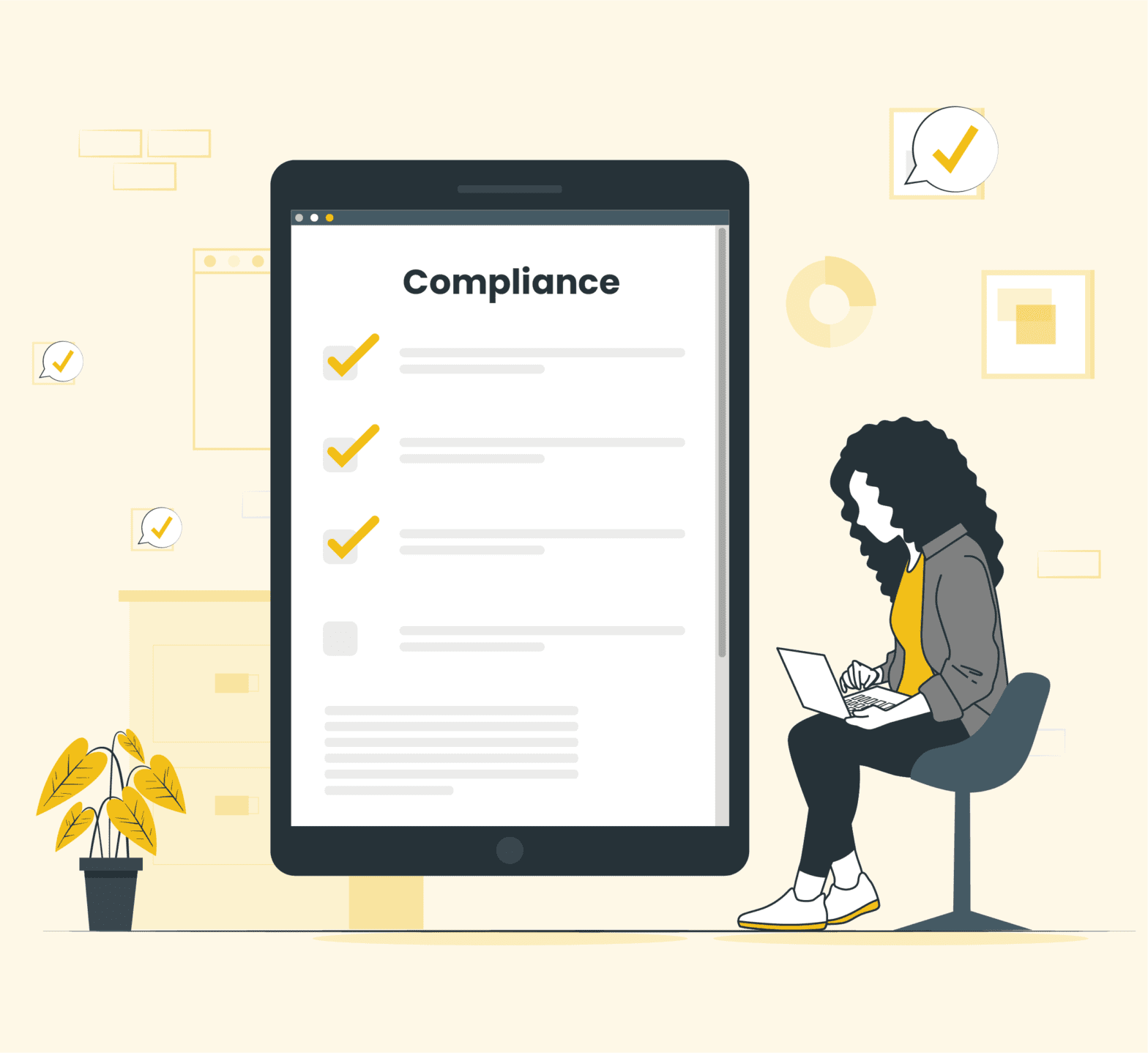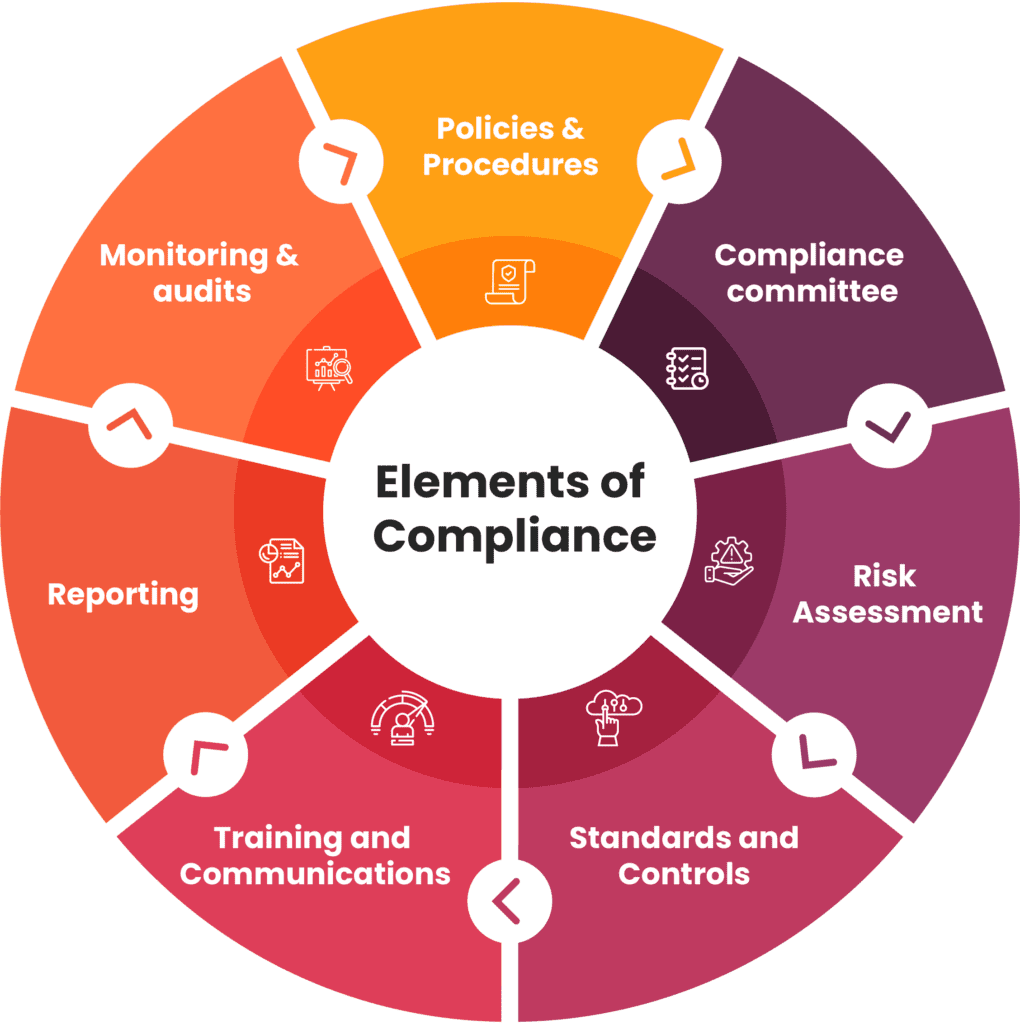Seven Elements of an Effective Compliance Program
With ever-evolving regulatory landscapes and frameworks, staying compliant is more of an ongoing effort today. Compliance programs keep an organization abreast with the changing regulations so as to avoid any legal implications. Therein lies the need, but compliance is a lot more than just following regulation and minimizing corporate misconduct. The very fabric of a compliance program is woven into daily business operations. It lays down principles and ethical standards, which influence the organization’s policies and continues in a loop, affecting risk management, oversight, monitoring, and corrective action.

An effective compliance program is never a quick fix but forms the backbone of an organization. According to the US Department of Justice (DoJ), simply having an off-the-shelf compliance program in place serves no purpose. The DoJ states that a company that has identified, assessed, and defined its risk profile is likely to stand tall when assessed or when under investigation. This results in lower risk exposure and fewer losses.
Key takeaways (TL;DR)
- Explore how an effective compliance program is the backbone of risk reduction, ethical culture, and regulatory confidence.
- Learn about the seven pillars—policies, committees, risk assessment, controls, training, reporting, and audits—drive true compliance excellence.
- Continuous training, monitoring, and anonymous reporting build trust and reinforce a culture of accountability.
- Continuous training, reporting, and audits ensure compliance stays active, transparent, and effective.
- See how VComply’s integrated GRC suite streamlines these elements, empowering organizations to stay agile, compliant, and audit-ready.
Given the importance of a compliance program, read on for a brief of what it entails, why companies need it, and how it can be implemented to address these needs through the various elements.
Compliance program: In a nutshell
The compliance program perfectly ties in several elements of compliant action. Right from prevention and assessment to collaboration and enforcement, it is usually all-inclusive. Such programs are best thought of as a bouquet of processes, policies and procedures. These help an organization follow compliance rules all across departments collectively. Further, a compliance program is a living entity of operation that lends itself to every sector equally.
What is the purpose of a compliance program?
One of its primary functions is to seamlessly aid any efforts made towards adopting new regulations. Companies need it to easily adapt without wasting resources. Besides these, the other reasons for needing a compliance program are:
- To lay down standards of operations
- To manage risks efficiently
- To integrate business operation with ethical norms
- To establish the right controls
- To institute oversight protocols
- To create a culture of compliance
- To remediate breaches and violations effectively

Seven Elements of Compliance program
1. Policies & procedures
For more insight on this subject, here’s how a compliance program addresses these needs through 7 essential elements.
A comprehensive compliance program is built on written policies that outline the expectations of the company. A good example is the code of conduct or code of ethics, which is broadly applicable to all individuals of the company, including the Board of Directors. This is a key part of any compliance program and through these companies can establish their operational standards to all. For instance, the Code of Conduct can instruct, educate, and guide employees as well as third-parties on how to conduct themselves during business engagements.
Another vital list of policies are the ones that facilitate the implementation of the compliance program. These outline the procedures for compliant action and articulate the importance of implementation and enforcement of the program.
2. Compliance committee
All compliance programs have a governing board led by a compliance manager. These committees comprise the board of directors, CEO, and senior members of the company. They are responsible for the successful execution of the compliance policies. Program oversight is one of the key tasks undertaken and in many cases, the board monitors the overall success of the policies.
Execution and implementation are delegated to a subcommittee, but this team receives reports on compliance on a regular basis. This enables routine assessments, which is crucial to the program. Besides oversight, this committee also plays a role in building a culture of compliance. When top management lives and breathes the compliance strategy, employees are likely to follow suit.
3. Risk Assessment
Assessing risk is the first step to the right formulation of a cohesive compliance program. However, risk assessment is not a one-time process, but an ongoing one that helps an organization be wary of the risk posing areas. Correct risk assessment over time will help the compliance manager and his or her team identify high risks and prioritize their remediation.
The risk assessment must be undertaken as a systemic approach under the guidelines of a compliance program and the idea is to spot the problems beforehand. It is recommended that every organization stick to rigorous risk assessments several times through the year or prior to launching new products or services. Naturally, this process is required by any company and is best handled through a compliance program. Without it, there is likely to be wastage or siloed risk management, which has proven ineffective.
4. Standards and Controls
For smooth operation, companies must have set standards of operation. Without these, there are numerous vulnerabilities at play, any of which could result in a breach or violation. However, establishing these standards and internal controls is part of an effective compliance program. Implementation includes defining and articulating standards that need to be laid out for every policy in effect.
That’s not all, internal controls are key to ensuring procedures are carried out as expected. The idea of establishing effective standards is to validate that your organization’s compliance program is living and active. Controls help ensure these through SOPs and various other mechanisms.
5. Training and Communications
A very essential aspect of a robust compliance program is training. From company officers, employees to third parties, everyone that forms a part of the organization internally and externally needs to be informed about compliance. This includes relevant laws and regulations, corporate policies, and barred conducts. To impart this training, compliance programs have set protocols to aid company efforts. Right from audience mapping to audience response, a compliance program will have defined procedures for each step.
Without the systematic approach offered by a dedicated program, companies can lose out on employees’ receptiveness or may lose touch with the objective. It is quite common that compliance training is only part of onboarding and then put on the sidelines. This does not reinforce the right ideals needed to function optimally in today’s environment.
6. Reporting
Traditionally, compliance issues or any other for that matter are handled by an HR team. While this can work, staying completely compliant requires active feedback across the board. A compliance program, through the committee and internal controls, enables this manner of reporting. Internally, within an organization, it enables the use of reporting hotlines to raise compliance issues.
Besides this, a compliance management system will have provisions to allow for anonymous reporting, which cultivates a culture of non-intimidation. Traditional approaches may not offer this and employees are less likely to engage in effective reporting if they fear for their jobs.
7. Monitoring & audits
Continuous monitoring is a key part of most compliance programs and companies benefit from it immensely. It is a critical part of risk assessment as it helps with the timely discovery of posing risks. Moreover, regular audits are part of the protocol. These improve the existing internal controls and facilitate accountability among employees.
As such, through this element of the compliance program, companies not only address their need for risk management but can subsequently improve on their existing systems.
How compliance software helps manage compliance programs
A modern compliance software centralizes policies, tasks, and evidence into one system of record, eliminating the risks of manual tracking in spreadsheets and email chains. It translates regulations and obligations into structured workflows, assigns responsibilities with clear due dates, and captures proof at every step. This not only reduces errors and blind spots but also makes it easier for organizations to stay audit-ready, demonstrate accountability, and build a culture of compliance across all teams.
How VComply helps manage compliance programs
VComply goes beyond being just a software tool, it acts as an operating system for compliance. It offers an integrated GRC suite to help various departments collaborate and take full control of compliance efforts. Teams can design controls that keep your organization compliant and agile, and entrust to stakeholders, monitor the progress, and implement regulatory frameworks. VComply helps streamline compliance efforts and offers a powerful set of tools for any professional.With VComply, organizations can map regulations into actionable tasks, automate reminders and approvals, and link policies directly to attestations and version histories. Its mobile-friendly platform ensures frontline employees can complete tasks and provide evidence anywhere, while managers gain real-time visibility into gaps, risks, and progress. By turning compliance into an ongoing, measurable process, VComply empowers organizations to shift from reactive fire-fighting to proactive, confident compliance execution.
Without a compliance program, the risk of engaging in misconduct is far too high. There is a hefty price for noncompliance including reputational damage and call for regulatory scrutiny. To avoid such negative implications and to formalize a winning compliance program, partner with VComply.
FAQ: Seven Elements of an Effective Compliance Program
Q1. What are the seven elements of an effective compliance program?
The seven elements, based on U.S. Department of Justice and HHS OIG guidance, are:
-
Written policies, procedures, and standards of conduct
-
Compliance oversight and governance (compliance officer/committee)
-
Training and education for employees
-
Effective communication channels, including reporting mechanisms
-
Monitoring, auditing, and risk assessments
-
Enforcement of standards through disciplinary measures
-
Prompt response and corrective action for identified issues
Q2. Why are written policies and procedures so important?
Policies and procedures establish the foundation of compliance. They define expectations, provide clear guidance to employees, and demonstrate to regulators that the organization has formalized standards to prevent misconduct.
Q3. What does compliance oversight mean in practice?
Oversight means appointing a compliance officer or committee with the authority, resources, and independence to run the program. It ensures accountability and provides a direct line of sight between compliance operations and executive leadership.
Q4. How should training and education be delivered?
Effective training is ongoing, role-based, and accessible. It should equip employees with practical knowledge on policies, regulatory requirements, and ethical decision-making, rather than being a one-time check-the-box activity.
Q5. What kinds of communication channels are necessary?
Employees must have safe, confidential, and accessible ways to ask compliance questions or report concerns — for example, hotlines, anonymous portals, or in-app reporting tools. Open communication reinforces a speak-up culture.
Q6. How do monitoring and auditing strengthen compliance programs?
Monitoring and auditing provide continuous oversight. By tracking obligations, reviewing evidence, and running risk assessments, organizations can identify issues early and prevent them from escalating into violations or fines.
Q7. Why is enforcement critical to program effectiveness?
Without consistent enforcement, compliance policies lose credibility. Clear, fair, and transparent disciplinary actions signal that standards apply equally across the organization, from frontline employees to executives.
Q8. What does “prompt response and corrective action” involve?
When issues or violations are discovered, organizations must investigate quickly, fix root causes, and document corrective measures. Regulators look closely at how organizations respond, proactive action can reduce penalties and build trust.
Q9. How can VComply support these seven elements?
VComply provides structure, accountability, and evidence. It centralizes policies, automates training and attestations, tracks audit trails, monitors tasks in real time, and provides channels for reporting and investigations, making the seven elements operational instead of theoretical.

